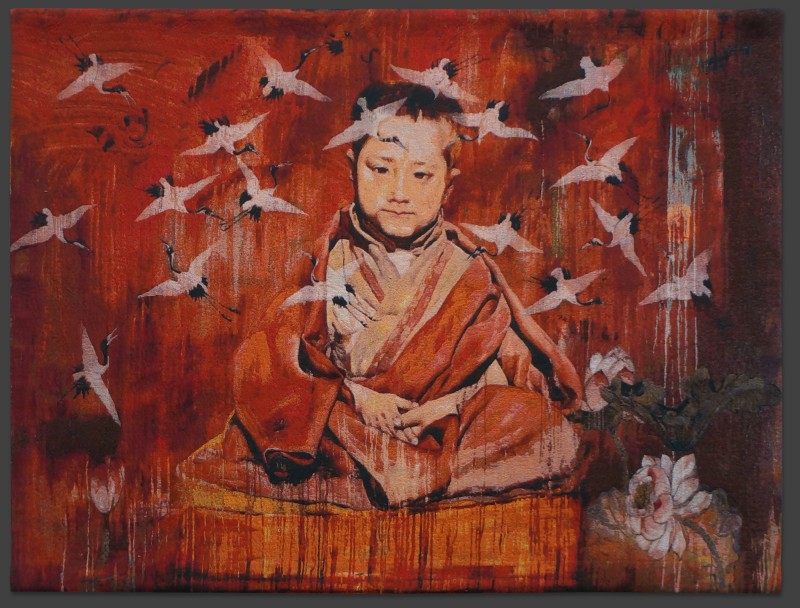
Jacquard tapestry
57 x 76 in.
Edition of 6
Chinese history has always been the essence of Hung Liu’s work: raised in Beijing during Mao’s Great Leap Forward and trained in the Social Realist tradition, Liu now uses painting as a means to reanimate historical photographs. “I hope to wash the subject of its exotic ‘otherness,’” she writes, “and reveal it as a dignified, even mythic figure.” The subject of Liu’s recent tapestry edition Above the Clouds possesses a double layer of this perceived exoticism – he is Lu Zo, a young Tibetan from the borderlands of China, where minority nationalities practice a spiritual tradition long associated with mystery and rebellion. Liu’s tapestry combines Zo’s beatific countenance with symbols from traditional Chinese iconography and her own uniquely expressionistic brushwork to reflect on this tiny, enigmatic figure’s journey of reincarnation.
Liu found the source photograph of Lu Zo in Lamas, Princes, and Brigands, a compilation of pictures taken by National Geographic photographer Joseph Rock in the 1920s and 30s. The caption identifies Zo as “last son of the ruler of Yongning, declared by authorities in Lhasa to be the incarnation of a high lama of Drepung Monastery.” It is an arresting image; where Liu’s 2009 tapestry Little Lama depicted an exalted young lama crowned with an elaborate headdress, Zo looks rather like a poor monk in his bare head and simple robe. Yet compared to his brother and sister, Zo’s face has an uncannily worldly look, as if centuries of reincarnation have already endowed him, says Liu, with an old soul.
Liu remarks that the Tibetan people and other outlying minorities have long held an exotic quality for the Chinese majority, likening their relationship to the limited Western understanding of Muslim peoples today. “Tibetans looked different, spoke a different language, and lived far away,” says Liu; “when the Dalai Lama escaped from China, he was treated by Han Chinese as a foreign invader.” The photograph, she explains, is from a world at a distance – geographically, culturally, linguistically, and across time. Zo’s physical body has long since passed away, but his status as a reincarnated lama and his curious, knowing expression suggest a spiritual longevity which transcends time and borders, a timelessness to which Above the Clouds pays a poetic tribute.
The tapestry’s palette is dominated by a faded, rusty red evocative of old bricks, the Chinese Imperial Garden walls and Tibetan robes; Liu calls it “a noble color,” one that suggests age and honor. The washes and drips of her original brushwork create an uneven, tumultuous surface; the shift to tapestry further complicates this surface by introducing the tension of vertical and horizontal threads, as if mirroring the complex layers of untold story and forgotten history that catalyze Liu’s practice. Zo is surrounded by lotus flowers, which are homonyms for “peace” in Chinese, and by a siege of hovering white cranes, which Liu reveals were inspired by a painting by a Song dynasty emperor famous for his calligraphy. The crane is an auspicious messenger from heaven in Chinese folklore but is practically unknown in Tibetan art: to combine the cranes with a Tibetan lama is “a cultural and religious collision,” says Liu, “but they look harmonious, as if they could remain that way forever.”
show prices
Prices and availability are subject to change without notice.The copyright of all art images belongs to the individual artists and Magnolia Editions, Inc.
©2003-2024 Magnolia Editions, Inc. All rights reserved. contact us
